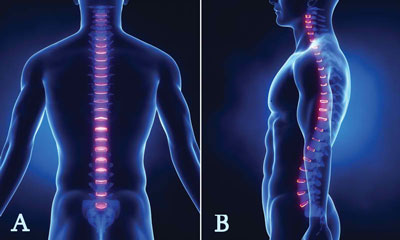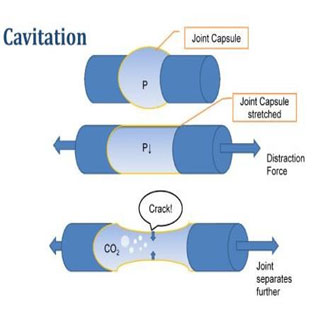Have you ever wondered how chiropractic works? Lots of people have questions about chiropractic and whether it is an evidence based technique for relieving neck and back pain as well as other symptoms. It is, and there is real science behind it!
At Precision Spinal Care, we want you to be well informed about what kind of care you can expect to receive. We also want you to be an active participant on your journey to recovery.
Dr. Packer has been practicing chiropractic care for 18 years and is board certified in the NUCCA technique. He also serves on the NUCCA Board of Directors as the Co-Chair of Education.
In this article, we will explore how the spine works, the two major categories of spinal issues, the importance of proper diagnosis, and what happens during a spinal adjustment.
How Does the Spine Work?
 Before we discuss what chiropractic is, a quick review of how your spine works is necessary in order to understand how your spine can affect your entire body.
Before we discuss what chiropractic is, a quick review of how your spine works is necessary in order to understand how your spine can affect your entire body.
Your spine is the central support structure for your head, chest, pelvis, shoulders, arms and legs. It is made up of several segments of bones, but it is flexible because of ligaments and spinal disks which allow you a wide range of motion.
Some sections of the spine are more flexible than others. The most flexible part is the neck or upper cervical area.
Your spine also houses and protects the spinal cord. Your spinal cord is the communication highway for your entire nervous system. Just like any other highway, if there is some sort of obstruction or bump in the road, your body will try to correct for it the same way a driver will try to correct for obstacles in a road. With spinal health, common “obstacles” are either anatomical or biomechanical in nature.
Most Spinal Issues Fall into Two Categories: Anatomical and Biomechanical
An anatomical condition would be a fracture, infection, tumor, or severely compressed nerve and/or herniated disc. If these issues exist, chiropractic is probably not the right fit for you.
A biomechanical condition is a when the joints don’t move or function properly. This misalignment of the spine can cause asymmetric loading on the bone, nerve or the disc, which can cause pain.
What Is Biomechanical Pathology
 Biomechanical pathology is a spinal ligament tear that alters the proper motion of the joint which can be caused by inactivity, repetitive asymmetric movements (certain jobs that require lifting, bending or stooping), or trauma (like a fall or car accident). This can result in the uneven distribution of weight on either side of the body that causes the muscles on the opposite side to overcompensate.
Biomechanical pathology is a spinal ligament tear that alters the proper motion of the joint which can be caused by inactivity, repetitive asymmetric movements (certain jobs that require lifting, bending or stooping), or trauma (like a fall or car accident). This can result in the uneven distribution of weight on either side of the body that causes the muscles on the opposite side to overcompensate.
When a spacer in a facet joint has too much load on it or is out of place, it can cause displacement of the spacer in between the joints and can irritate the surface of each facet joint. This instability and misalignment can cause pain in the joint itself as well as the surrounding nerves.
Over time, adhesions can form scar tissue (lesions) which further aggravate the joint. The development of scar tissue can increase the number of nerves as well as nerve sensitivity. The end result is pain as well as the loss of flexibility and strength.
Biomechanical lesions can also cause misalignment and lead to changes in balance. The imbalance can cause disc degeneration throughout the spine. The end result is irritated joints, discs, and inflammation of nerve endings which result in pain.
The Importance of Diagnosing the Primary Problem
Proper evaluation and diagnosis of the primary problem is imperative. The body will try to compensate for imbalances caused by the primary lesion on the spine. If left untreated, these lesions can cause spasms along the spine, more pain, and permanent biomechanical failure (arthritis).
Therefore, it is imperative to find the cause of the imbalance or the primary lesion. Treating the symptoms or regional spasms or compensatory spasms and misalignments along the spine may make you feel better temporarily.
However, treating symptoms only will not take care of the problem. Failure to find and correct the problem will only lead to more spinal issues, pain, and possible permanent damage.
The way to pinpoint and properly diagnose the primary lesion is through the use of biomechanical x-rays. Precise measurements of the spine are made in order to determine the exact point of the primary lesion and/or misalignment.
At Precision Spinal Care, we use the AMA Guides to the Evaluation of Permanent Impairment, 5th Edition. This manual gives precise guidance to measurements and quantifies the “loss of motion segment integrity” when spinal ligaments are compromised.
Digital x-rays demonstrate exactly where the ligament damage is. Proper examination of the x-rays allows the doctor to calculate the adjustments required to restore proper spinal function and stability. Spinal ligaments are not properly visualized on standard MRIs; therefore, the AMA recommends measuring the altered motion on x-ray to determine where the ligaments have become compromised and are causing the abnormal motion.
The goal is to find the source of your pain, correct it, and get you on your way to recovery.
Pain and the Brain
Pain from the spine gets transmitted up the spinal cord to the brain and back. Studies have revealed functional changes between brain regions that process and modulate pain before and after a chiropractic adjustment.
What Happens During a Chiropractic Adjustment?
 Adjustment of a spinal joint involves a variety of techniques designed to move the spinal vertebrae back into a more stable position. This, in effect, allows the spacer of the facet joint to be put back in position, thus diminishing the irritation of the pain sensors on the facet surfaces.
Adjustment of a spinal joint involves a variety of techniques designed to move the spinal vertebrae back into a more stable position. This, in effect, allows the spacer of the facet joint to be put back in position, thus diminishing the irritation of the pain sensors on the facet surfaces.
The adjustment also may create movement into the joint, which allows for straightening of the ligament fibers (repair of scar tissue). Such straightening of the fibers helps the ligament become stronger, more flexible and less sensitive to pain. Remember, the spinal ligaments are the guidewires to the proper positioning of the spinal bones, so their repair is necessary to allow people to “hold” their adjustments.
Studies have shown that stretching and PT (active and passive motion) do not heal the spinal ligaments as effectively as an adjustment which actually creates motion within the joint itself. Proper spinal correction also helps break the pain cascade. Chiropractic adjustments have shown to release chemicals (neuro-peptides) which affects inflammation and pain.
What is the sound I hear when I get a chiropractic adjustment?
Synovial fluid, which has lubricating properties, cavitates (creates space) and absorbs much of the energy during adjustment and creates the sound you hear when getting adjusted. The sound is the effect of the joint being rapidly stretched as a cavity is created within the joint.
Is Chiropractic Care Right for You?
Adjusting affects the central nervous system and decreases pain by modulation of areas in the brain (demonstrated on functional MRIs). It also decreases mechanical sensitivity of the spinal joints and targets spinal ligaments for transition of scar tissue to healthy ligaments.
At Precision Spinal Care we follow best practice guidelines for NUCCA care. It is a safe and painless, evidence-based approach to correct spinal problems. Pinpointing and alleviating the cause of your neck and back pain is our goal.
A thorough neurological, orthopaedic and biomechanical examination is the most important thing you can do to determine whom you should see about your neck and back pain.
At Precision Spinal Care, we will perform a thorough examination of you before any treatment is performed or prescribed. If it is determined that your pain is anatomical, we’ll explain your condition and recommend the type of specialist who is most appropriate for you.
We understand that you need to explore all your options when you look for expert chiropractic care. At Precision Spinal Care, we are happy to help you determine the best way to address your specific needs.
Call our office at (757) 382-5555 to speak to the doctor or set up a consultation. You can also set up an appointment through our webpage.

